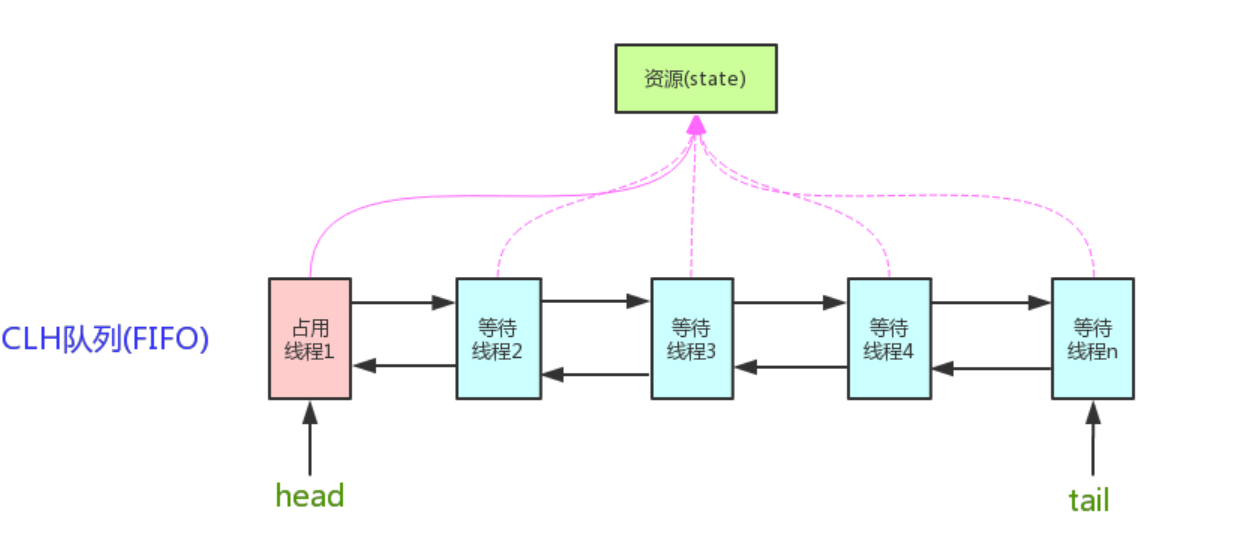JUC(八)-AbstractQueuedSynchronizer之AQS
本文最后更新于:2024年4月22日 下午
AQS即是抽象的队列式的同步器,熟知的ReentrantLock、ReentrantReadWriteLock、CountDownLatch、Semaphore等都是基于AQS来实现的。
基本原理
是用来构建锁或者其它同步器组件的重量级基础框架及整个JUC体系的基石,通过内置的FIFO队列来完成资源获取线程的排队工作,并通过一个int类变量表示持有锁的状态
CLH:Craig、Landin and Hagersten 队列,是一个单向链表,AQS中的队列是CLH变体的虚拟双向队列FIFO
AQS中 维护了一个volatile int state(代表共享资源)和一个FIFO线程等待队列(多线程争用资源被阻塞时会进入此队列)
这里volatile能够保证多线程下的可见性,当state=1则代表当前对象锁已经被占有,其他线程来加锁时则会失败,加锁失败的线程会被放入一个FIFO的等待队列中,比列会被UNSAFE.park()操作挂起,等待其他获取锁的线程释放锁才能够被唤醒
另外state的操作都是通过CAS来保证其并发修改的安全性
AQS的基本API
- getState():获取锁的标志state值
- setState():设置锁的标志state值
- tryAcquire(int):独占方式获取锁。尝试获取资源,成功则返回true,失败则返回false
- tryRelease(int):独占方式释放锁。尝试释放资源,成功则返回true,失败则返回false
AQS源码
以ReentrantLock为例,加锁过程
1、尝试加锁
2、加锁失败,线程放入队列
3、线程入队列后,进入阻塞状态
非公平锁NonfairSync为例,案例都是理想正常流程执行 A-B-C 线程执行,实际上有差异
Lock方法(挂起线程)
static final class NonfairSync extends Sync {
private static final long serialVersionUID = 7316153563782823691L;
/**
* Performs lock. Try immediate barge, backing up to normal
* acquire on failure.
*/
final void lock() {
if (compareAndSetState(0, 1))
setExclusiveOwnerThread(Thread.currentThread());
else
acquire(1);
}
protected final boolean tryAcquire(int acquires) {
return nonfairTryAcquire(acquires);
}
}compareAndSetState 比较state,这里A先进入比较并交换 设置state0到1,AQS实现,
protected final boolean compareAndSetState(int expect, int update) {
return unsafe.compareAndSwapInt(this, stateOffset, expect, update);
}
protected final void setExclusiveOwnerThread(Thread thread) {
exclusiveOwnerThread = thread;
}
此时B线程执行lock开始抢占锁,此时非常抱歉,此时state=1,那么B只能进入acquire方法
模板方法进入AbstractQueuedSynchronizer的acquire方法,注意:tryAcquire 方法AbstractQueuedSynchronizer本身不实现,会抛出UnsupportedOperationException异常
public final void acquire(int arg) {
if (!tryAcquire(arg) &&
acquireQueued(addWaiter(Node.EXCLUSIVE), arg))
selfInterrupt();
}而非公平NonfairSync里面的实现
protected final boolean tryAcquire(int acquires) {
return nonfairTryAcquire(acquires);
}final boolean nonfairTryAcquire(int acquires) {
final Thread current = Thread.currentThread();
int c = getState();
if (c == 0) {
if (compareAndSetState(0, acquires)) {
setExclusiveOwnerThread(current);
return true;
}
}
else if (current == getExclusiveOwnerThread()) {
int nextc = c + acquires;
if (nextc < 0) // overflow
throw new Error("Maximum lock count exceeded");
setState(nextc);
return true;
}
return false;
}由于此时C=1,并且getExclusiveOwnerThread=A ,所以此时返回false
接下来执行父类模板定义的方法
acquireQueued(addWaiter(Node.EXCLUSIVE), arg)
private Node addWaiter(Node mode) {
Node node = new Node(Thread.currentThread(), mode);
// Try the fast path of enq; backup to full enq on failure
Node pred = tail;
if (pred != null) {
node.prev = pred;
if (compareAndSetTail(pred, node)) {
pred.next = node;
return node;
}
}
enq(node);
return node;
}private Node enq(final Node node) {
for (;;) {
Node t = tail;
if (t == null) { // Must initialize
if (compareAndSetHead(new Node()))
tail = head;
} else {
node.prev = t;
if (compareAndSetTail(t, node)) {
t.next = node;
return t;
}
}
}
}此时tail=null,enq 自旋先创建哨兵节点,用于占位,再创建b节点入队,并将Node 头尾节点设置
final boolean acquireQueued(final Node node, int arg) {
boolean failed = true;
try {
boolean interrupted = false;
for (;;) {
final Node p = node.predecessor();
if (p == head && tryAcquire(arg)) {
setHead(node);
p.next = null; // help GC
failed = false;
return interrupted;
}
if (shouldParkAfterFailedAcquire(p, node) &&
parkAndCheckInterrupt())
interrupted = true;
}
} finally {
if (failed)
cancelAcquire(node);
}
} for (;;)这里又是一个自旋,
第一次自旋,tryAcquire去抢锁,这里默认A 休眠五分钟,所以这里肯定抢占失败返回false,执行shouldParkAfterFailedAcquire 将p也就是当前的哨兵节点,此时哨兵节点pred的waitStatus=0,条件进入比较并交换为-1。
第二次自旋,shouldParkAfterFailedAcquire 哨兵节点pred的waitStatus=-1,此方法返回true,便执行parkAndCheckInterrupt中的方法,此时就把线程B挂起
private final boolean parkAndCheckInterrupt() {
LockSupport.park(this);
return Thread.interrupted();
}unLock 方法(唤醒线程)
unlock—>sync.release(1)—>tryRelease 子类实现
public final boolean release(int arg) {
if (tryRelease(arg)) {
Node h = head;
if (h != null && h.waitStatus != 0)
unparkSuccessor(h);
return true;
}
return false;
}protected final boolean tryRelease(int releases) {
int c = getState() - releases; // 1-1=0
if (Thread.currentThread() != getExclusiveOwnerThread())
throw new IllegalMonitorStateException();
boolean free = false;
if (c == 0) {
free = true;
setExclusiveOwnerThread(null);
}
setState(c);
return free;
}tryRelease=0,返回true,执行unparkSuccessor,此时node是头节点是哨兵节点 waitStatus=-1,下一节点B将执行
LockSupport.unpark(s.thread)。也就是B节点线程唤醒
private void unparkSuccessor(Node node) {
/*
* If status is negative (i.e., possibly needing signal) try
* to clear in anticipation of signalling. It is OK if this
* fails or if status is changed by waiting thread.
*/
int ws = node.waitStatus;
if (ws < 0)
compareAndSetWaitStatus(node, ws, 0);
/*
* Thread to unpark is held in successor, which is normally
* just the next node. But if cancelled or apparently null,
* traverse backwards from tail to find the actual
* non-cancelled successor.
*/
Node s = node.next;
if (s == null || s.waitStatus > 0) {
s = null;
for (Node t = tail; t != null && t != node; t = t.prev)
if (t.waitStatus <= 0)
s = t;
}
if (s != null)
LockSupport.unpark(s.thread);
}